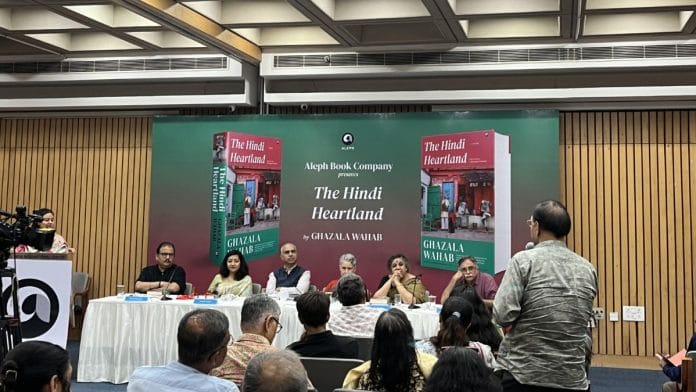New Delhi: At the launch of Ghazala Wahab’s latest book, The Hindi Heartland — which dissects the politics and culture of India’s most fractious region —Rajya Sabha MP and RJD spokesperson Manoj Kumar Jha said: “If the idea of India is to be preserved, the Hindi Heartland has to learn some good manners.”
He was referring to the seven states in the north that cover 38 per cent of India’s landmass. It’s now known for having become a petri dish of communal tension, economic backwardness, and diversity that “has been weaponised for political reasons”.
The release event at Delhi’s India International Center looked at the various angles that have come to define the politics of the Hindi belt, and emphasised what has become the India of yore —stubbornly diverse and syncretic in its traditions. This was assessed by a cast of eminent panelists: writer and author Ghazala Wahab, Jha of the RJD, and Professors Ira Bhaskar, Peggy Mohan, and Amar Farooqui. Political analyst Rashid Kidwai moderated the discussion.
“The commonly held idea of India comes from this region. It was the creator of two religions, where tolerance was not a virtue but a way of life,” said Wahab, explaining the genesis of the book.
She also reiterated its importance in “the age of alternate reality and opportunist history”.
Nearly all the speakers referred to a single arena, a battleground of division that stems from the freshly mown cultural politics of the region. Language wars are being waged across the country, and the imposition of Hindi is a lingering fear— even in the age of AI.
However, Hindi is also associated with a specific context, that of jokes and popular culture. It isn’t necessarily seen as a ‘serious language’. This also plays a role in the perception of the language and the geographical barriers within which it is located.
But these debates, according to Professor Mohan, refuse to acknowledge the elephant in the room: the aspiration of English.
“You’re seeing a huge amount of translation coming out of India, especially in the last two years. But it’s not because the government wants Hindi or Tamil –– it’s because of the public,” she said. “There’s a subtle point. Hindi is not only about cracking jokes and films; it is also about extremely nuanced subjects, and people are playing around with it to get the silkiness of Urdu. That’s coming now.”
Also read: Goddesses, scarecrows and circuses—20 new Madhvi Parekh paintings on display at DAG
Urdu in Hindi
To situate the politics of today, History professor Amar Farooqui, who retired from Delhi University, and Ira Bhaskar, a professor of film at Jawaharlal Nehru University (JNU), relied on the past.
“One of the strengths of this book is the way in which it looks at the longer history of how society was disrupted,” said Farooqui. “As the anti-colonial struggle developed, the Indian nation was identified with the Hindu nation. And that was an idea that served useful to organisations like the RSS and the Hindu Mahasabha.”
He went on to refer to the now commonplace ideas of Muslim rulers being regarded as “foreign invaders” and the popular desire to reinvent a glorious Hindu past.
“It’s a historical process that didn’t just begin with the formation of the RSS a hundred years ago. It began much earlier, particularly due to the disruptive role played by colonialism. These are the oldest conquests when she [Wahab] is talking about the core areas of the heartland,” Farooqui added.
Meanwhile, Professor Bhaskar took note of India’s film history and the landscape within which these narratives unfolded. The ending of Garam Hava (1974), starring Balraj Sahni, takes place right after Partition. The character played by Sahni is just about to leave for Pakistan when his son gets off their tonga and “joins a procession that is asking for rights—the right for everyone to have food, shelter, and employment.”
“Muslim social was a specific genre that emerged in the 1940s because of communal pressure, because there was a lot of criticism that Muslims were backward. They weren’t ready to enter modernity and were stuck in the past,” Bhaskar said.
When it comes to language, according to Bhaskar, it’s nearly impossible to “excise the Urdu words from the Hindi” —highlighting shared histories and cultures. She dived into poetic connections and bonds that cannot be severed.
“There are so many examples. But I know today the situation is dire,” she said. “I want to hold on to the power of poetry and music in India.”
In response, Jha quipped: “One is the world of nostalgia, and one is the real world.”
(Edited by Ratan Priya)






